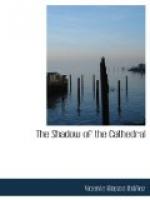Gabriel ceased his contemplation, seeing that he was no longer alone in front of the church. It was nearly daylight, and several women with bowed heads, their mantillas falling over their eyes, were passing in front of the iron grating. The crutches of a lame man rang out on the fine tiles of the pavement, and, out beyond the tower, under the great arch of communication between the archbishop’s palace and the Cathedral, the beggars were gathering in order to take up their accustomed positions at the cloister door. The faithful and “God’s creatures” [1] knew one another; every morning they were the first occupants of the church, and this daily meeting had established a kind of fraternity, and with much coughing and hoarseness they all lamented the cold of the morning and the lateness of the bell-ringer in coming down to open the doors.
[Footnote 1: Pordioseres.]
A door opened beyond the archbishop’s arch, that of the tower and the staircase leading to the dwellings in the upper cloister. A man crossed the street rattling a huge bunch of keys, and, followed by the usual morning assemblage, he proceeded to open the door of the lower cloister, narrow and pointed as an arrow-head. Gabriel recognised him, it was Mariano, the bell-ringer. To avoid being noticed he remained motionless in the Piazza, allowing those to pass first through the Puerta del Mollete,[1] who seemed so anxious to hurry into the Metropolitan church, lest their usual places should be stolen from them and occupied by others.
[Footnote 1: Door of the rolls, or loaves.]
At last he decided to follow them, and slowly descended the same steps leading down into the cloister, for the Cathedral, being built in a hollow, is much lower than the adjacent streets.
Everything appeared the same. There on the walls were the great frescoes of Bayan y Maella, representing the works and great deeds of Saint Eulogio, his preaching in the land of the Moors, and the cruelties of the infidels, who, with big turbans and enormous whiskers, were beating the saint. In the interior of the Mollete doorway was represented the horrible martyrdom of the Child de la Guardia; that legend born at the same time in so many Catholic towns during the heat of anti-Semitic hatred, the sacrifice of the Christian child, stolen from his home by Jews of grim countenance, who crucified him in order to tear out his heart and drink his blood.
The damp was rapidly effacing this romantic fresco, that filled the sides of the archway like the frontispiece of a book, causing it to scale off; but Gabriel could still see the horrible face of the judge standing at the foot of the cross, and the ferocious gesture of the man, who with his knife in his mouth, was bending forward to tear out the heart of the little martyr; theatrical figures, but they had often disturbed his childish dreams.




